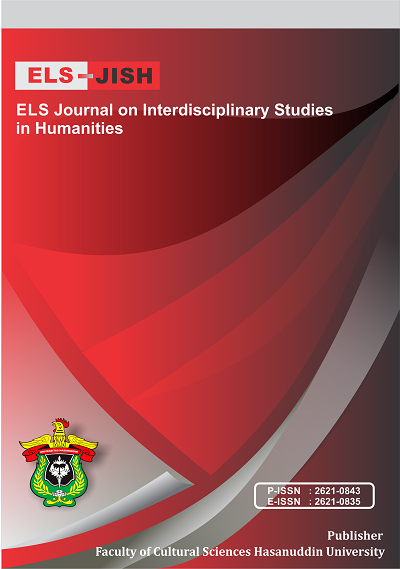Discourse Analysis and Humor on Papuan Mop in the Series of “Epen Kah Cupen Toh”
DOI:
https://doi.org/10.34050/elsjish.v6i1.25642Keywords:
Discourse Analysis, Humor, Papuan MOP, Papuan DialectAbstract
This study aims to explore the humor and discourse in Papuan MOP, as depicted in the 2010 YouTube video series "Epen Kah Cupen Toh" (EKCT). Humor reflects different cultures and societal conditions, and MOP is a frequently used humor by Papuan people, making it a unique representation of their lives. The study utilizes qualitative analysis to identify patterns and themes in Papuan MOP humor and discourse. The primary data is collected from the transcription of EKCT video series. Discourse analysis was utilized to further analyze the transcription of videos as the primary data. The findings reveal that the primary type of humor in Papuan MOP is witticism, and the character "Dodi" represents the effects of a lack of education and underdeveloped society in certain areas of the Papuan region. Furthermore, the use of the Papuan Melayu dialect, which emphasizes monosyllabic sounds, adds to the uniqueness of the humor portrayed in the series. The cross-cultural representation in the series also highlights the diverse ethnicities in Indonesia. The study concludes that Papuan MOP humor is closely linked to the social conditions of Papuan people, making it a valuable aspect of their cultural heritage.
References
Budiarsa, I. M. (2015). Language, dialect and register sociolinguistic perspective. RETORIKA: Jurnal Ilmu Bahasa, 1(2), 379-387.. https://doi.org/https://doi.org/10.22225/jr.1.2.42.379-387
Cope, M. (2009). Transcripts (Coding and Analysis). In International Encyclopedia of Human Geography (Vol. 1, pp. 350–354). Elsevier Inc. https://doi.org/10.1016/B978-008044910-4.00549-6
Dalyan, M., Darwis, M., Rahman, F., & Latjuba, A. Y. (2022). Cultural Discourse in Indonesian Humor: A Case Study of Some Short Dialogues. Theory and Practice in Language Studies, 12(5), 1009-1018.
Dynel, M. (2009). Beyond a joke: Types of conversational humour. Linguistics and Language Compass, 3(5), 1284–1299. https://doi.org/10.1111/j.1749-818X.2009.00152.x
Hadiati, C. (2018). Humor is Some Linguistic Perspectives. Conference: The Third Conference on Language. https://doi.org/https://www.researchgate.net/publication/324795696_Humor_is_Some_Linguistic_Perspectives
Kamalu, I., & Osisanwo, A. (2015). Discourse Analysis. In Issues in the study of language and literature (pp. 169–195). Kraft Books Limited. https://doi.org/https://www.researchgate.net/publication/343214812_DISCOURSE_ANALYSIS
Kluge, A. (2017). A grammar of Papuan Malay (M. Haspelmath, Ed.; Vol. 78). Language Science Press. https://doi.org/http://dx.doi.org/10.5281/zenodo.376415
Rahman, F. (2018). The Constraints of Foreign Learners in Reading English Literary Works: A Case Study at Hasanuddin University. Journal of Arts and Humanities, 7(2), 01-12.
Rahman, F., Abbas, H., Akhmar, A. M., & Tahir, M. D. (2023). The Men and the Sea: Cultural Preservation of Bajau People with their Traditional Practice in Bone Regency. Journal of Positive Psychology and Wellbeing, 820-835.
Sen, A. (2012). Humour analysis and qualitative research. Social Research Update, 1 (63). https://sru.soc.surrey.ac.uk/SRU63.pdf
Sianipar, B., & Somantri, G. R. (2022). Development and Democratization in Papua. Journal of Positive School Psychology, 6(8), 225-231. https://journalppw.com/index.php/jpsp/article/view/9711/6337
Sukaton, O. (2019). Semantics in Natural Language Processing and Language Teaching. ELS Journal on Interdisciplinary Studies in Humanities, 2(1), 58–65. https://doi.org/https://doi.org/10.34050/els-jish.v2i1.6008
Warami, H. (2016). Tipologi Wacana MOP “Humor” Dalam Masyarakat Papua: Identifikasi Dan Eksplorasi. Kibas Cendrawasih, 13(1), 17–30. https://doi.org/https://doi.org/10.26499/kc.v13i1.98
Downloads
Published
Issue
Section
License
Copyright (c) 2023 Aldrin Yohanes Ferdinandus, Ounu Zakiy Sukaton, Patrisius Istiarto Djiwandono

This work is licensed under a Creative Commons Attribution-ShareAlike 4.0 International License.






